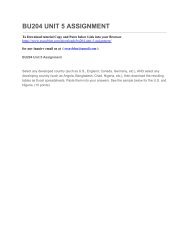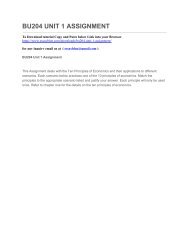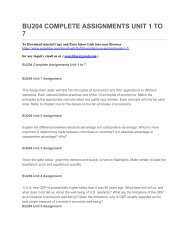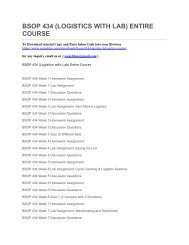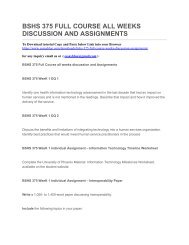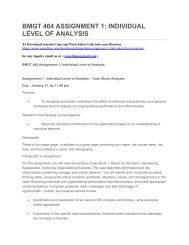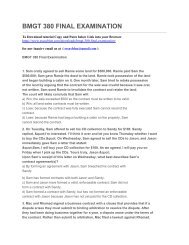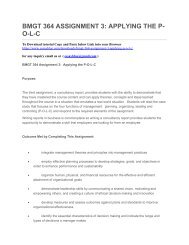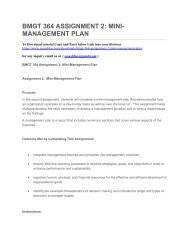BSOP 429 PRODUCTION ACTIVITY CONTROL AND JUST-IN-TIME WITH LAB – FULL COURSE
Create successful ePaper yourself
Turn your PDF publications into a flip-book with our unique Google optimized e-Paper software.
<strong>BSOP</strong> <strong>429</strong> <strong>PRODUCTION</strong> <strong>ACTIVITY</strong> <strong>CONTROL</strong><br />
<strong>AND</strong> <strong>JUST</strong>-<strong>IN</strong>-<strong>TIME</strong> <strong>WITH</strong> <strong>LAB</strong> <strong>–</strong> <strong>FULL</strong><br />
<strong>COURSE</strong><br />
To Download tutorial Copy and Paste below Link into your Browser<br />
https://www.essayblue.com/downloads/bsop-<strong>429</strong>-production-activity-control-just-time-lab/<br />
for any inquiry email us at ( essayblue@gmail.com )<br />
<strong>BSOP</strong> <strong>429</strong> Production Activity Control and Just-in-Time with Lab <strong>–</strong> Full Course<br />
<strong>BSOP</strong> <strong>429</strong> Week 1 Written Assignment<br />
<strong>BSOP</strong> <strong>429</strong> Week 1 Discussion 1 How Other Levels of OPC Affect PAC (graded)<br />
<strong>BSOP</strong> <strong>429</strong> Week 1 Discussion 2 Compare and Contrast JIT and MRP (graded)<br />
<strong>BSOP</strong> <strong>429</strong> Week 2 Written Assignment<br />
<strong>BSOP</strong> <strong>429</strong> Week 2 Lab 1 of 6: The Scheduling Lab<br />
<strong>BSOP</strong> <strong>429</strong> Week 2 Discussion 1 Lead Times (graded)<br />
<strong>BSOP</strong> <strong>429</strong> Week 2 Discussion 2 Lab 1 Discussion (graded)<br />
Q & A Forum for your questions and comments (not graded)<br />
<strong>BSOP</strong> <strong>429</strong> Week 3 Written Assignment<br />
<strong>BSOP</strong> <strong>429</strong> Week 3 Lab 2 of 6; Lab Scheduling<br />
<strong>BSOP</strong> <strong>429</strong> Week 3 Discussion 1 Types of Constraints (graded)<br />
<strong>BSOP</strong> <strong>429</strong> Week 3 Discussion 2 Lab 2 Discussion (graded)<br />
<strong>BSOP</strong> <strong>429</strong> Week 4 Written Assignment<br />
<strong>BSOP</strong> <strong>429</strong> Week 4 Lab 3 of 6; Scheduling, Reporting and Feedback<br />
<strong>BSOP</strong> <strong>429</strong> Week 4 Discussion 1 PAC Feedback (graded)<br />
<strong>BSOP</strong> <strong>429</strong> Week 4 Discussion 2 Lab 3 Discussion (graded)<br />
<strong>BSOP</strong> <strong>429</strong> Week 4 Midterm Exam (2 Versions)<br />
<strong>BSOP</strong> <strong>429</strong> Week 4 Midterm <strong>–</strong> Set 1
1. (TCO 12) _____ is the objective under JIT and time-based competition. (Points : 5)<br />
2. (TCO 2) Which of the following lead-time elements can be compressed into one welldesigned<br />
PAC system? (Points : 5)<br />
3. (TCO 3) What happens to inventory as the number of kanban cards increases? (Points : 5)<br />
4. (TCO 1) In managing supplier relations, which of the following is a beneficial setup? (Points :<br />
5)<br />
5. (TCO 6) When linking marketing requirements and manufacturing strategy, what design<br />
approaches for shop floor system should be considered? (Points : 5)<br />
6. (TCO 9) Which of the following is true? (Points : 5)<br />
7. (TCO 4) According to Elyahu Goldratt, the TOC system uses a scheduling approach called<br />
_____. (Points : 5)<br />
8. (TCO 5) The amount of time covered by the basic MRP record is called the _____. (Points :<br />
5)<br />
Page 2<br />
1. (TCO 1) Please explain PAC. (Points : 20)<br />
2. (TCO 2) How does input from other areas into PAC and the feedback PAC provides impact<br />
PAC? Explain. (Points : 20)<br />
3. (TCO 6) Discuss the differences between MRP and JIT. (Points : 20)<br />
<strong>BSOP</strong> <strong>429</strong> Week 4 Midterm <strong>–</strong> Set 2<br />
1. (TCO 12) Formal systems for shop floor control under JIT are _____.<br />
2. (TCO 2) An operation setback chart _____.<br />
3. (TCO 3) In order to minimize the number of orders waiting in the queue and maximize the<br />
number of orders processed in a center, which of the following rules should be used?
4. (TCO 1) Which of the following is true?<br />
5. (TCO 6) When linking marketing requirements and manufacturing strategy, what design<br />
approaches for shop floor system should be considered?<br />
6. (TCO 9) Which of the following is true?<br />
7. (TCO 4) How much of total lead time is accounted for by queue time?<br />
8. (TCO 5) Gross requirements in an MRP record are _____ because they are stated as unique<br />
items for a given period.<br />
Essay Type<br />
1. (TCO 1) List and briefly discuss the five main parts of the operations planning control (OPC)<br />
system.<br />
2. (TCO 2) What information should be provided into PAC as feedback and why they are<br />
important?<br />
3. (TCO 6) Compare and contrast JIT and MRP.<br />
<strong>BSOP</strong> <strong>429</strong> Week 5 Written Assignment<br />
<strong>BSOP</strong> <strong>429</strong> Week 5 Lab 4 of 6; JIT and PAC<br />
<strong>BSOP</strong> <strong>429</strong> Week 5 Discussion 1 Reducing the Wall of Inventory (graded)<br />
<strong>BSOP</strong> <strong>429</strong> Week 5 Discussion 2 Lab 4 Assignment (graded)<br />
<strong>BSOP</strong> <strong>429</strong> Week 6 Written Assignment<br />
<strong>BSOP</strong> <strong>429</strong> Week 6 Lab 5 of 6<br />
<strong>BSOP</strong> <strong>429</strong> Week 6 Discussion 1 Supply Chain for JIT Operations (graded)<br />
<strong>BSOP</strong> <strong>429</strong> Week 6 Discussion 2 (Lab 5 Assignment) (graded)<br />
<strong>BSOP</strong> <strong>429</strong> Week 7 Written Assignment<br />
<strong>BSOP</strong> <strong>429</strong> Week 7 Lab 6 of 6; Critical Path Method<br />
<strong>BSOP</strong> <strong>429</strong> Week 7 Discussion 1 Implementation (graded)<br />
<strong>BSOP</strong> <strong>429</strong> Week 7 Discussion 2 Lab 6 Assignment (graded)
<strong>BSOP</strong> <strong>429</strong> Week 8 Final Exam<br />
1. (TCO 4) The priority rule, which will sequence jobs in the order they are received, is _____.<br />
(Points : 5)<br />
2. (TCO 2) In an assignment method problem, if it takes Abe 3 hours to build a birdhouse and 4<br />
hours for a doghouse, and Betty takes 4 hours for a birdhouse and 3 hours for a doghouse,<br />
what is the reduced cost (in hours) of assigning Betty to build the doghouse? (Points : 5)<br />
3. (TCO 2) A major difference between manufacturing and service systems in terms of<br />
scheduling is (Points : 5)<br />
4. (TCO 3) Scheduling in service systems may involve scheduling which of the following?<br />
5. (Points : 5)<br />
6. (TCO 5) The owner and operator of the local franchise of Handyman, Inc., has four jobs to<br />
do today, shown in the order they were received:<br />
7. (TCO 6) Building up an inventory of standard parts or modules instead of immediately<br />
producing the finished end items is the essence of (Points : 5)<br />
8. (TCO 7) With regard to suppliers, JIT systems typically require (Points : 5)<br />
9. (TCO 10) Which of the following is characteristic of the JIT philosophy? (Points : 5)<br />
10. (TCO 1) In make-to-stock systems, fluctuations in sales volume are managed through which<br />
of the following? (Points : 5)<br />
11. (TCO 5) In an MRP master schedule, the planning horizon is often separated into a series of<br />
times periods called (Points : 5)<br />
Page 2<br />
1. (TCO 8) Explain how cellular manufacturing represents a flexible manufacturing system.<br />
(Points : 25)<br />
2. (TCO 11) State the four building blocks of lean operations, and explain how fast and simple<br />
are the two common threads that run through them. (Points : 25)<br />
3. (TCO 9) Elaborate on the statement: “The output of the system cannot exceed the output of<br />
the bottleneck operation(s).” (Points : 25)
4. (TCO 4) Differentiate between infinite loading and finite loading as two major approaches<br />
used to load work centers. (Points : 25)<br />
5. (TCO 12) The theory of constraints has a goal of maximizing flow through the entire system.<br />
(Points : 25)<br />
6. (TCO 2) Refer to the following data for jobs waiting to be processed at a single work center<br />
(jobs are shown in order of arrival):<br />
7. (TCO 10) Respond to the question: “Which is better, MRP or JIT?” (Points : 25)<br />
8. (TCO 1) The design of the MPC system is influenced by some key features of market<br />
demand and product design. Name the key features that will lead to an assemble-to-order<br />
system and explain the rationale. (Points : 25)<br />
9. (TCO 6) Market requirements drive the choice of the shop floor system approach. Describe<br />
and explain the type of market requirements that would be suitable for an MRP-based<br />
system, along the lines of product design, product variety, product volume per period,<br />
product mix changes, and delivery schedule changes. (Points : 25)<br />
10. (TCO 10) Manufacturing strategy also drives the choice of shop floor system. Describe and<br />
explain the strategies that lend themselves to a JIT-based system, from the perspective of<br />
WIP, changeover cost, and process choice. (Points : 25)<br />
<strong>BSOP</strong> <strong>429</strong> Week 8 Final Exam <strong>–</strong> Set 2<br />
1. (TCO 4) The two different approaches to load work centers in job-shop scheduling are<br />
(Points : 5)<br />
2. (TCO 2) The priority rule where jobs are processed according to the smallest ratio of due<br />
date to processing time is (Points : 5)<br />
3. (TCO 2) A scheduling rule used for sequencing jobs through two work centers is (Points : 5)<br />
4. (TCO 3) The owner and operator of the local franchise of Handyman, Inc., has four jobs to<br />
do today, shown in the order they were received:………………….If he uses the first-come,<br />
first-served (FCFS) priority rule to schedule these jobs, what will be the average completion<br />
time? (Points : 5)<br />
5. (TCO 5) The ultimate goal of JIT operations is to have (Points : 5)
6. (TCO 6) Building up an inventory of standard parts or modules instead of immediately<br />
producing the finished end items is the essence of (Points : 5)<br />
7. (TCO 7) A kanban card is used to signal that (Points : 5)<br />
8. (TCO 10) The type of processing system that is used for highly standardized products is<br />
(Points : 5)<br />
Page 2<br />
1. (TCO 8) Does cellular manufacturing apply best to repetitive, high-volume product or<br />
nonrepetitive, low-volume product? Explain and give an example. (Points : 25)<br />
2. (TCO 11) Validate or invalidate the statement that although inventories are maintained, the<br />
goal of lean operations is to maintain a minimum of safety stock. (Points : 25)<br />
3. (TCO 9) Elaborate on the statement: “The output of the system cannot exceed the output of<br />
the bottleneck operation(s).” (Points : 25)<br />
4. (TCO 4) Differentiate between infinite loading and finite loading as two major approaches<br />
used to load work centers. (Points : 25)<br />
5. (TCO 12) Explain why batch process helps maximize worker efficiency. (Points : 25)<br />
6. (TCO 2) Refer to the following data for jobs waiting to be processed at a single work center<br />
(jobs are shown in order of arrival):………………………… Batch job requires specialized<br />
operations carried out by different workers or group of workers and so there is a need for<br />
more specialization and standardization. What is the schedule sequence using the firstcome,<br />
first-served (FCFS) priority rule? (Points : 25)<br />
7. (TCO 10) Respond to the question: “Which is better, MRP or JIT?” (Points : 25)<br />
8. (TCO 1) The design of the MPC system is influenced by some key features of market<br />
demand and product design. Name the key features that will lead to a make-to-stock system<br />
and explain the rationale.(Points: 25)<br />
9. (TCO 6) Market requirements drive the choice of the shop floor system approach. Describe<br />
and explain the type of market requirements that would be suitable for an MRP-based<br />
system, along the lines of product design, product variety, and product volume per period,<br />
product mix changes, and delivery schedule changes. (Points : 25)<br />
10. (TCO 10) Manufacturing strategy also drives the choice of shop floor system. Describe and<br />
explain the strategies that lend themselves to a JIT-based system, from the perspective of<br />
WIP, changeover cost, and process choice. (Points : 25)





